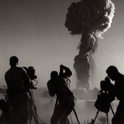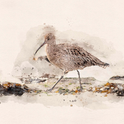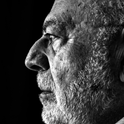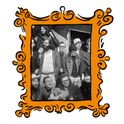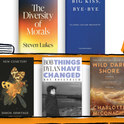December in England in 1973 was a dark time. Due to an ongoing shortage of coal, the government had announced a national three-day week for the use of electricity, beginning on New Year’s Eve. Power was already rationed in shops: window displays went unlit, and customers in branches of Boots did their Christmas shopping by the pharmacist’s bulbs, which were permitted to stay on.
Into this bleak midwinter came a hero who both embodied and defied its gloom: Raymond Briggs’s Father Christmas. Fifty years later, the dark art of Briggs’s comic-style picture book is what I always look forward to reading most with my children at December bedtimes, because its world is so magically immersive. It has almost no drama, but it is all depth. The simplest plot summary would be: over two days and one night, an old man grumbles around his own house and other people’s houses. And as he does so, we follow him from light into darkness and back again.
Light and warmth are what this gruff but gentle character wants most. The book begins with their loss: Father Christmas, under a cat and a quilt, dreams of lounging on a tropical beach. The alarm clock literally bursts his bubble, leaving it an oval of pale fragments, as though a cheerful postcard had become a church window. “‘Tis the year’s midnight, and it is the day’s,” wrote John Donne of the winter solstice. But working people still have to get out of bed on dark mornings—and Father Christmas is one of them.
Briggs, who died last year, often said that the character of Father Christmas was based on his own father, Ernest, a milkman. I wonder if there was also a fictional inspiration for the opening pages, though. The use of literary allusion in Briggs’s later, slime-smeared masterpiece, Fungus the Bogeyman (1977), makes clear he was well read. And one of the books that Fungus contemplates on a shelf of modern classics is A Portrait of the Artist as a Young Bogeyman, its title a bogeyfication of James Joyce’s autobiographical novel.
Here’s my theory: certain early panels of Father Christmas would serve perfectly as illustrations for the slow, homely breakfast time by which Joyce introduces Mr Leopold Bloom, the hero of his next book, Ulysses. Father Christmas—whose favourite muttered word is “Blooming”—feeds his cat just like Bloom (“poured warmbubbled milk on a saucer and set it slowly on the floor”); puts a kettle on and returns to “a plume of steam from the spout”; and finally—and most Joyceanly—goes to the outside lavatory, where he sits glaring at the loo-roll holder (Bloom reads one of the scraps of newspaper he keeps handy for the same purpose). Joyce got a letter of protest from Ezra Pound, who disliked his “detailed treatment of the dropping feces”; Briggs received one from the wife of an American minister, who objected to “the act of personal hygiene” and thought he should apologise to children everywhere (he hung this letter, framed, in his lavatory).
Bloom, though, lives with his wife; Father Christmas is a loner. One of the mysteries of the book is that he appears to inhabit a brick terraced house at the North Pole, with its own British microclimate. His local paper, the Arctic Echo, leads with “SNOW, SNOW AND MORE SNOW”—and some newspapers in the early 1970s did apocalyptically report predictions of global cooling, based on recent harsh winters. But the actual stuff on the ground as he trudges about his work is a modest inch at most, barely covering his bootsoles (in 1973, there was no white Christmas anywhere in the UK).
As Father Christmas prepares to clock on, you feel the sympathy between character and illustrator, who own work ethic is evident in the attention lavished on every drab surface: the hand-pointed bricks of the house; the curved metal-roofed sheds adjoining it; the varied grain and shades of the garden fence planks. “I once kept a record of the time it took to do two pages,” Briggs said. “Pencilling—20 hours, inking—18 hours, colouring—25 hours. And all that’s after months of getting ideas, writing and planning.”
Father Christmas has evidently spent months preparing for these pages too: trundling a galvanised wheelbarrow with accidentally festive red wheel and green handles, he heaps his sleigh with wrapped presents from a padlocked shed, like so much coal, then hauls a tarpaulin over the lot. And this, pretty much, is the first and last we see of them. The contents of the packages themselves are a matter of indifference to Father Christmas, as to any delivery driver (returning home on Christmas morning, he ignores parcels on the mat: “seen enough of those things”). Instead, what Briggs unwraps for his young readers is something much more interesting: their world at night.
The first roof on which Father Christmas leaves tracks is a stony rural cottage with a hefty end chimney. Every double page of the book cuts its comic-strip grid differently. Here, the house is shown in cross-section, as Father Christmas struggles down the deep flue, only to have to climb back up to the top floor, where two children sleep with stockings at the end of the bed and chamber pots underneath.
Lavatory arrangements matter in this world: they signify class, and its economic relationship to modernity. The next house is larger, newer and better-off: with the outside wall cut away, we see a bathroom with flushing toilet and heated towel rail. Here, the stockings are pillowcases, and there is a bottle of something left out by the fireplace. It is based on Briggs’s own home on the edge of the South Downs, as Ethel and Ernest (1998), his pictorial biography of his parents, confirms: their art student son buys a house in the same place, as well as the blue Volkswagen camper van seen in Father Christmas.
Geographically, the route of the Christmas Eve journey doesn’t make much sense: starting in the frozen North, it stops first in southern England, then heads back to London, where the lighted terrace in party mode is modelled after Briggs’s childhood home in Wimbledon. Like the annual traditions of Christmas itself, though, Father Christmas’s flight is really a journey through time: in a Wimbledon terrace attic, we see the wooden tea chests once used for fragile decorations before families had plastic storage boxes.
Then comes a wonderfully unnecessary moment, which in its deadpan grandeur is perhaps the artistic heart of the book. A page spread presents Father Christmas sitting in the white trough between two peaked roofs. You can see from his footprints that he has climbed both chimneys. As his reindeer feed from a sack, and the moon glows on the sloped snow, it’s time for the nightshift worker’s packed lunch: apple, banana, sandwiches and a thermos. Those mince pies and sherry barely touched the sides.
To end the night, we get a montage of challenging dwellings—an igloo, a lighthouse, a caravan—followed by an early morning greeting (“Still at it, mate?”) from the ghost of Briggs’s father, who died in 1971 (the milkfloat’s registration plate gives his initials and birth: ERB 1900). Again, we are back in London, for the final stop: a battleship-grey Buckingham Palace.
There is a kind of dour democracy in Briggs’s rendering of the Royal residence as a house no more aesthetically appealing than any of the others visited—not to mention the fact that it is Father Christmas’s last call rather than his first. But this also means he ends at the epicentre of Christmas ritual in Britain, with the family who introduced the fir tree to the Victorian home, and—to Briggs’s parents’ generation—the monarch’s speech.
Father Christmas has performed his ritual role, binding the nation together in a single night of gift-giving. Although the essentials of the night before Christmas were established by the early 19th-century American poem “A Visit from St. Nicholas”, the universality of the stocking was still a relatively recent development in Britain. As the historian Ronald Hutton notes, both working-class and royal households preferred New Year’s gifts until about 1900, and crofters in the Northern Isles kept up this tradition until the 1960s.
One contemporary reviewer cited Briggs’s book as proof that “Christmas has become a secular ritual”—there are no churches, choirs or nativities here. Our hero returns home to all the mundane domestic rituals in reverse: feed the animals, stow the sleigh, boil the kettle, change clothes. But then he does Christmas in a recognisable way: turkey and pudding in the oven; singing carols in the shower; “good drop of ale”; brandy, cigar and party hat (how did he pull the cracker?); awful presents from distant cousins; washing up, TV, cocoa, bed. As for most people, Father Christmas’s Christmas is much less thrilling than it’s cracked up to be.
Why, then, is it so satisfying? The answer, I think, is the beautifully painterly story that Briggs tells about light and dark through the book. We end back in the bedroom, but now its floral wallpaper is cosy yellow rather than dawn grey. Father Christmas hasn’t arrived on a beach—that’s for the picaresque sequel, Father Christmas Goes on Holiday (1975)—but he’s back in bed, beginning a nice long period of annual leave.
Over 28 pages, he has returned to the colour and warmth promised by his broken dream and kept alive, like a flame, by cheerful objects we see along the way: his wall posters of Mediterranean destinations (Capri, Malta); the glowing cheddar and mango chutney with which he makes his sandwiches; the orange winter windows of the Wimbledon terrace and Buckingham Palace; the lighthouse beam on which he, impossibly, perches his sleigh. Light is a solid good in this world, a substance and a kind of food.
The book ends with food as a gift. Some of its visual ideas about midwinter festivity echo Briggs’s illustrations for James Reeves’s seasonal anthology, The Christmas Book (1968). Reeves’s selections also have a strong emphasis on feasting, and Briggs envisions with relish lines such as Robert Herrick’s “Drink now the strong beer, / Cut the white loaf here”.
The final page of Father Christmas suggests another literary allusion—to the anonymous, folklorish passage printed by Reeves that celebrates the generosity of “whosoever on ye night of ye nativity of ye yonge Lord Jesus, in ye greate snows, shall fare forth bearing a succulent bone for ye lost and lamenting hounde”.
Father Christmas’s dog stares sadly from the window when he leaves; his faithfulness is rewarded in the penultimate panel by what is obviously a gift-wrapped bone. What’s the point of putting a bow on a bone for a dog? It’s a symbol of Raymond Briggs’s Christmas realism: the everyday object given to readers with a touch of warm, comic red.

